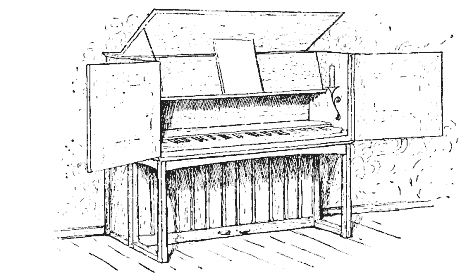
[From The Studio vol 10 No 49 Apl 1897]
BY
THOSE who have read that exquisite " Gossip on Romance," by Robert Louis Stevenson, may remember how he shows that the aim of the writer of fiction should be to fit to a particular place its appropriate story to make the right thing happen in the right place, and so satisfy the imagination of the reader ; and he goes on to describe in quaint and beautiful language how this has been done by the great writers of romance.
To the architect a somewhat similar task presents itself. He must first use the divining power of his imagination to discover the particular kind of house which his site demands, and try to express in bricks and mortar the spirit of the countryside ; he must then, having built the right kind of house to harmonise with a particular site, finally com plete his task by furnishing this right kind of house with the right kind of furniture.
For it is not enough that furniture should possess intrinsic beauty, unless it also possesses this further quality of exquisite appropriateness to its position and to its use. It should appear almost to be a piece of the room in which it is placed and in absolute harmony with its surroundings.
It is in this respect that the various kinds of fixed furnishings become of especial value in the effect of a room, filling the gap between the house and its furniture, and thus giving an appearance of unity and harmony. The fixed seats to the ingle-nook, the mantel-pieces and bedroom fitments, all appear as part of the structure itself and so form a connecting link between the movable furniture and the house.
The essential point then in the choice of furniture may be said to be not so much the individual merit of a particular thing as its relation to everything else in the room. The furniture should appear to grow out of the requirements of the room, to represent the finishing touches of a scheme which had its inception when the first stone of the house was laid, and not an alien importation from the upholsterer's of spick and span suites, at war with themselves and their surroundings.
The usual method of huddling together indiscriminately a variety of articles which have no possible relation to each other, will prove merely an expensive advertisement of the bad taste of the owner, and will suggest nothing more homelike than the cabinet-maker's shop.
Perhaps when we have begun to learn that the artist may be better employed in refining and sim-plifying the surroundings of home-life than in producing an infinitude of mediocre pictures, some-thing may be done towards regaining some of those qualities Much seem to have been gained so easily and so inevitably in all earlier age. 'Pill then one can only duplorc the immense amount of ignoble and misdirected labour which has resulted in the making of so much that is vulgar and base. If we consider what an incalculable amount of true pleasure both to craftsman and purchaser might be gained in the making and keeping of rightly designed work, and if we imagine such work, carried out in something of the spirit which inspires that description by Kudyard Kipling of the attitude of the true artist worker
Who, lest all thought of Eden fade,
Sends laden to the crafts-man's brain,
To Godlike muse, or his own trade,
And manlike stand with God again.
If we compare with such a picture the mechanical drudge of the modern workshop, we must conclude that the cheapest of educations will hardly atone for the loss of the traditional knowledge of generations of workmen, or for the substitution of a bare commercialism for the old craftsman spirit.
The furniture of the average modern upholsterer will be quite out of the question for those who wish to possess a tastefully furnished house. It is not implied that the commercial article is necessarily too cheap, or that better furniture would be necessarily more expensive. Many people appear to imagine that they cannot afford to have artistic surroundings, whereas the wonder is that they can afford so much expensive ugliness. For the vulgarity of most of the furniture of the shops has been painfully acquired at the expense of much misdirected labour, and if shorn of its so-called ornament it would often be at least inoffensive.
There is the dining-room suite in black oak, the whole character of which seems to be summed up appropriately in the one word "antique," and which the purchaser, unmindful of a great gulf fixed, fondly imagines to have all the effect of old work. It would be difficult to fund anything more debased than these solemn caricatures, and yet ;hey are often to be found in the houses of cultivated people. Some simple designs for dining-room furniture are shown among the illustrations to this article. The side-board in plain oak on page 155, and the rush-bottomed chair, on page 156, would be suitable in a small house; while the up-holstered chair on the same page would be appropriate to a rather more ambitious establishment.
In the average drawing-room we find Art in capital letters everywhere, and the use here of this prefix may be generally taken to signify the absence of any real artistic merit.
The art of the drawing-room ! What a medley of painted milking stools, and mirrors, chip-carved tables, trays and photograph frames the term suggests, what a fatal tendency to decorate the most inappropriate things in the most inappropriate places with the most inappropriate designs. To carve the surfaces of tea-trays and tables and to paint on mirrors and chairs ! There seems a great need for some kind of directing intelligence to the enormous amount of industry displayed in the various minor arts which arc now so much practised. If we take art needlework alone and examine the numerous specimens to be found in such profusion in the average drawing-room, will not the resulting impression be a feeling of sadness that so much industry has been so much misapplied? And then, on looking closer, we find everywhere under the silk the blue lines of the bought design -

COTTAGE PIANO DESIGNED BY M.H. BAILLIE SCOTT.
the naturalistic spray of flowers or fruit. The importance and possibilities of design are quite underrated or ignored. A " design " is something bought at a shop which may or may not be "pretty," and that is all. On the other hand, an immense reverence is paid to technique, the fineness of the stitches and the general neatness and accuracy of the work.
Perhaps one of the most curious manifestations of the art of the drawing-room is to be found in the hand painted mirrors in plush frames, which have been so much in vogue.
It would be difficult to find anything more
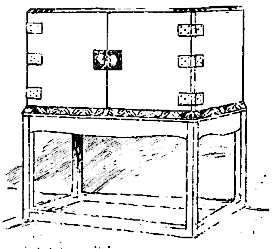
CABINET, STAINED GREEN, WITH WHITE METAL MOUNTS DESIGNED BY M.H. BAILLIE SCOTT.
hopelessly illogical than this mode of decoration, because if we wish to look at the painting we are dazzled by the mirror, while the mirror itself entirely loses its raison d'etre, so that painting and mirror contrive to frustrate and neutralise each other in the most charming way. Amongst the drawing-room furniture which is illustrated in this article mention must be made first of the cottage piano on this page which has been carried out by Messrs. Broadwood.
This represents an attempt to realise something more artistic than the ordinary type of case, in which the keyboard projects as an excrescence from the main body of the piano. It was felt that in order to obtain a satisfactory result the keyboard should be incorporated in the case, and with this object the sides and top of the piano have been
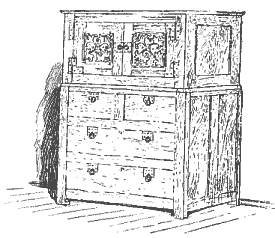
CLOTHES PRESS DESIGNED BY M.H. BAILLIE SCOTT.
extended to the front line of the keyboard. The removal of the candles to a position where they will light the music without dazzling the eyes of the player, and the substitution of a long shelf with sloping back for the usual inadequate music rack, are both practical improvements on the ordinary type of piano, while the projecting sides and top act as sounding boards, and so immensely improve the acoustic properties of the instrument. This case has been carried out in oak, stained a dark rich green, with hinges in white metal. The essential novelty is, however, the form of the case, which would lend itself readily to many kinds of decorative treatment.
Some few other examples of drawing-room furniture are here illustrated also. The small secretaire (page 157) may be carried out in oak, with metal work of repoussie copper. The cabinet on page 154 may be finished in the green and silver scheme which has been mentioned for the piano.
Although we may occasionally find a dining-room or even a drawing-room furnished in an artistic way, it is rarely that art penetrates so far as the bedrooms. At this stage the wearied and jaded householder accepts with a passive despair the suites of the upholsterer. They are generally in birch, and the wardrobe has a broken pediment secured with glued blocks, while on each side of the mirror are carved panels finished with mechanical precision. Were it not for disfiguring the pages of a magazine set apart for artistic work, it might be instructive to reproduce here some of this furniture in order to illustrate the above remarks by actual examples.
A few simple designs for bedroom furniture are illustrated. The wardrobe on page 157 may be carried out in oak, with wrought iron hinges. The washing-stand on the same page may be finished in white enamel, with tiles and jug in blue and white; while on this page is shown a clothes-press, which perhaps makes a more satisfactory piece of furniture than the ordinary chest of drawers.
The bed itself is generally either in badly designed cast iron or in coarsely moulded brasswork. If it is to be in metal, it seems a pit), that so little has been clone towards arriving at a good design ; and there certainly seems here a field for the use of simple wrought iron work or delicately moulded brass. It should, if possible, be placed in a recess, or at least in some position where it appears as a part of the room. In carrying out the furnishing and decoration of the bedroom it may be suggested that each should be named after and decorated with some particular flower.
Thus the poppy bedroom might have these flowers symbolical of sleep introduced in the wall-paper and furniture, and if suitable motives were added, such a scheme would have a very unique effect. Other flowers such as the rose and lily may also be suggested.
One of the main faults in modern furnishing is overcrowding ; and just as it is thought artistic to
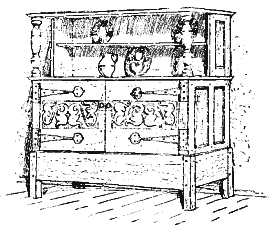
SIDEBOARD IN PLAIN OAK DESIGNED BY M.H. BAILLIE SCOTT.
cover every square yard of our walls with ornament, so we do not consider our houses furnished till the floors are covered and cumbered with useless furniture.
Most of this exists apparently but for one object, to be kept clean, and so to afford an outlet for those vigorous and misapplied energies which are the mark of the British housekeeper.
The most reasonable basis from which to start in furnishing is obviously the actual practical requirements of the particular family, and the wisest course to pursue will probably be to acquire gradually, as they are needed, the necessary articles of furniture, without reference to conventional ideas or the dictates of fashion. Instead of crowding as many things together as possible, it will be better to remove everything which is not essential, and to aim at having a few choice things rather than many inferior ones.
It is rarely that the artistic value of economy is appreciated in the furnishing and decoration of the home. In most cases it is a deplored necessity, preventing the full realisation of an artistic ideal which sees no possible perfection but that of costly magnificence, and which tests the artistic value of every article by its price in the market. The necessary restrictions imposed by a limited purse often prove to be the best safeguards against vulgar extravagance ; and so to those who can
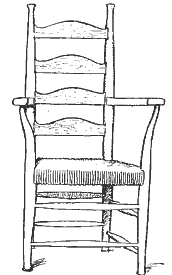
RUSH-BOTTOMED CHAIR DESIGNED BY M.H. BAILLIE SCOTT.
appreciate the beauty of simplicity and restraint, necessity in this case may become a virtue in-deed, and instead of trying to emulate the splendours of the palace, so often vulgar, so seldom comfortable and homely, we may accept gladly the limitations which suggest a more cottage-like Home, And in this way we may be happy in realising Mr. Ruskin's description of a country home, which may be quoted here as a fitting conclusion to this series of articles.
"And in actual life let me assure you in conclusion, the first 'wisdom of calm' is to plan and
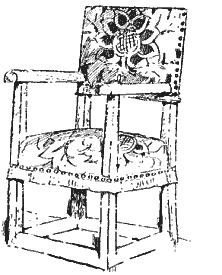
UPHOLSTERED ARM CHAIR DESIGNED BY M.H. BAILLIE SCOTT.
resolve to labour for the comfort and beauty of a home such as, if we could obtain it, the would quit no more. Not a compartment of a model lodging-house, not the number so-and-so of Paradise Row . but a cottage all of our own, with its little garden its pleasant view, its surrounding fields, its neighbouring stream, its healthy air, and clean kitchen, parlours, and bedrooms. Less than this no man should be content with for his nest; more than this few should seek ; but if it seem to you impossible, or wildly imaginary that such houses should ever be obtained for the greater part of the English people, again believe me the obstacles which are in
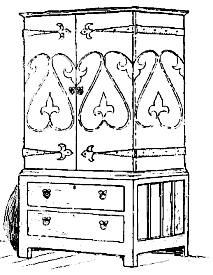
OAK WARDROBE, WITH WROUGHT IRON HINGES DESIGNED BY M.H. BAILLIE SCOTT.
the way of our obtaining them arE the things which it must be the main object now of all true science, true art, and true literature to overcome."
M.H. BAILLIE SCOTT.
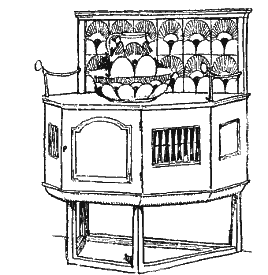
WASHING STAND IN WHITE ENAMEL-TILES AND CROCKERY IN BLUE AND WHITE DESIGNED BY M. H. BAILLIE SCOTT
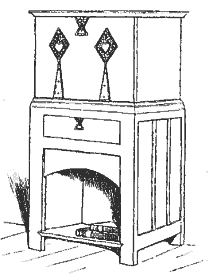
SECRETAIRE IN OAK, HINGES IN REPOUSSE COPPER DESIGNED BY M. H. BAILLIE SCOTT
The illustrations accompanying the above article are from sketches made by the author.
|
|
||
|
|
||
|
Any comments, errors or omissions gratefully received
The Editor © F.Coakley , 2003 |
||